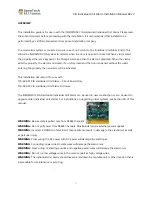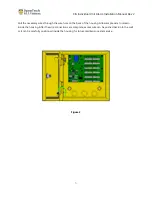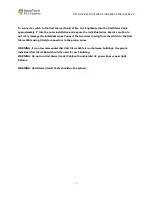
CIA Individual Unit Alarm Installation Manual Rev 2
9
The wires for each door switch should be punched down on the terminal strip using the proper
tool. Recommend punch down tool is .156 inch IDC T handle. Do not use a telephone punch down
tool or screwdriver. The punch down connectors should be removed from the circuit board before
the wires are punched down. Place the punch down connectors on a hard surface. Do not punch
down wires while the connector is attached to the Unit Alarm Board as this can damage the circuit
board.
DOOR SWITCHES
Depending on the door type, there are several different door switches that can be used with the
CIA Individual Unit Alarm board. When selecting door switches it is recommended that a wide gap
switch is used. Below is a list of selected door switches that are compatible with the system. These
switches are provided by the installation company.
Amseco AMS-37L Series magnetic contact can be used for swing or roll up doors. When mounted
on roll up doors it is recommended to use a Z-Bracket (4270004). Additional information on
Amseco magnetic switches can be found at
https://www.pottersignal.com/product/206/ams-37-series
QuickSwitch can be used on both roll up and swing doors if the door latch is made of ferrous metal and is
long enough to go all the way through the door switch.
Recessed switches such as the Amesco AMS-21 (
https://www.pottersignal.com/product/246/ams-21-
https://www.pottersignal.com/product/282/ams-26-series
) can be used for
swing doors.
UNIT ALARM (TRUNK) CABLE
For new installations it is recommended that 22 or 24 AWG solid core unshielded cable is used for
connection to the individual unit door contacts. It is also recommend that UG crimp connectors are
used for connecting the individual switches to the unit alarm (trunk) cable.
The unit alarm (trunk) cable is typically routed from the Individual Unit Alarm Board through the
building to each of the units that will be monitored. The wires from the unit switch connect to the
unit alarm (trunk) cable above the door. One wire from the switch will connect to a unique
individual wire and the other wire will connect to the ground or common wire. The ground or
common wire can be shared between multiple switches. For troubleshooting purposes, it is
recommended that one ground or common wire is shared with four unit switches. The Unit Alarm
Connection Worksheet can be used to document the wiring connection and wire color code.



































